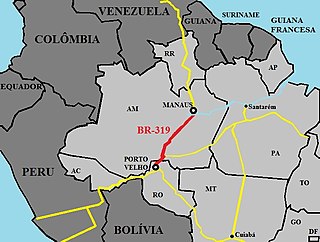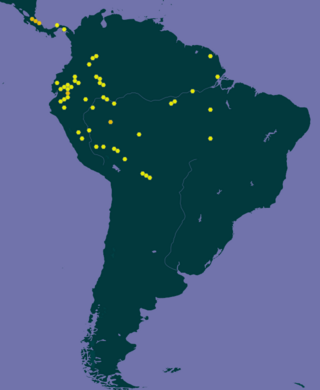
Amazonas is a state of Brazil, located in the North Region in the north-western corner of the country. It is the largest Brazilian state by area and the ninth-largest country subdivision in the world. It is the largest country subdivision in South America, being greater than the areas of Chile, Paraguay, and Uruguay combined. Neighbouring states are Roraima, Pará, Mato Grosso, Rondônia, and Acre. It also borders the nations of Peru, Colombia and Venezuela. This includes the Departments of Amazonas, Vaupés and Guainía in Colombia, as well as the Amazonas state in Venezuela, and the Loreto Region in Peru.

Manaus is the capital and largest city of the Brazilian state of Amazonas. It is the seventh-largest city in Brazil, with an estimated 2022 population of 2,063,689 distributed over a land area of about 11,401 km2 (4,402 sq mi). Located at the east centre of the state, the city is the centre of the Manaus metropolitan area and the largest metropolitan area in the North Region of Brazil by urban landmass. It is situated near the confluence of the Negro and Amazon rivers. It is one of the two cities in the Amazon Rainforest with a population of over 1 million people, alongside Belém.

The pied tamarin, sometimes referred to as the Brazilian bare-faced tamarin, is a critically endangered species of primate found in a restricted area of the Brazilian Amazon Rainforest. It was named the mascot of Manaus, Brazil in 2005. The species is endangered due to the increasing size of the city of Manaus which is encroaching on their native habitat.

The North Region of Brazil is the largest region of Brazil, accounting for 45.27% of the national territory. It has the second-lowest population of any region in the country, and accounts for a minor percentage of the national GDP. The region is slightly larger than India and slightly smaller than the whole European Union. It comprises the states of Acre, Amapá, Amazonas, Pará, Rondônia, Roraima, and Tocantins.

Glycydendron is a genus of plants, under the family Euphorbiaceae first described as a genus in 1922. It is native to South America.
- Glycydendron amazonicumDucke - French Guinea, Suriname, Guyana, Ecuador, Peru, Bolivia, northwestern Brazil, possibly Colombia
- Glycydendron espiritosantenseKuhlm, - State of Espírito Santo in Brazil

Dipteryx is a genus containing a number of species of large trees and possibly shrubs. It belongs to the "papilionoid" subfamily – Faboideae – of the family Fabaceae. This genus is native to South and Central America and the Caribbean. Formerly, the related genus Taralea was included in Dipteryx.

The National Institute of Amazonian Research is a public educational and research institution headquartered in Manaus, Brazil. It was founded in 1952, with the purpose of furthering scientific knowledge of the Brazilian Amazon Region. Most of INPA's research focuses on tropical forest management, ecology, molecular ecology, zoology, botany, tropical agriculture and tropical pisciculture. The institution also maintains important vertebrate, invertebrate, and vascular plants research collections.

The Rio de Janeiro Botanical Garden or Jardim Botânico is located at the Jardim Botânico district in the South Zone of Rio de Janeiro.
Adolpho Ducke, , was a notable entomologist, botanist and ethnographer specializing in Amazonia. According to family records, he was an ethnic German with roots in Trieste Austro-Hungary. German was his first language; that is, the German commonly spoken in Trieste in the 19th century. Most of his books were written in German.

Dipteryx charapilla is a little-known species of flowering plant in the family Fabaceae, a large to mid-sized tree growing along rivers in the rainforests of Brazil. and Peru.

The Balbina Dam is a hydroelectric dam and power station on the Uatumã River in the Amazon Rainforest, Brazil. The location is under the municipality of Presidente Figueiredo jurisdiction, in the state of Amazonas.
Fontes do Ipiranga Biological Reserve is a biological reserve in the Fontes do Ipiranga State Park in São Paulo State, Brazil.

The Amazon Tall Tower Observatory or ATTO is a scientific research facility in the Amazon rainforest of Brazil. This includes a 325-metre-tall (1,066 ft) tower that extends far above the forest canopy and two 80-metre (260 ft) towers that allow researchers to collect samples from the soil surface to above the forest canopy. Additionally, there are climate-controlled containers for laboratory equipment and an office, a base camp and nearby sites for studying vegetation and soil processes. The tall research tower is one metre taller than the Eiffel Tower and is currently the tallest structure in South America. All towers are equipped with a broad range of instruments to measure chemical and physical properties of the atmosphere, such as greenhouse gas concentrations, aerosols and meteorological data.
Chromolucuma is a genus of plants in the family Sapotaceae described in 1925.

The Amazon biome contains the Amazon rainforest, an area of tropical rainforest, and other ecoregions that cover most of the Amazon basin and some adjacent areas to the north and east. The biome contains blackwater and whitewater flooded forest, lowland and montane terra firma forest, bamboo and palm forest, savanna, sandy heath and alpine tundra. Some areas of the biome are threatened by deforestation for timber and to make way for pasture or soybean plantations.

The Tarumã Açu River is a river in the state of Amazonas, Brazil. It is a left tributary of the Rio Negro, which it enters just west of the city of Manaus.

The Tucuruí transmission line is a hydroelectric power line that leads north from the Tucuruí Dam in Pará, Brazil and crosses the Amazon River. From there the eastern branch leads to Macapá in Amapá and the western branch leads to Manaus in Amazonas. The towers supporting the span across the Amazon River are nearly as high as the Eiffel Tower. Work to extend the line from Manaus north to Boa Vista, Roraima, is due to complete in 2018. There were delays in issuing the environmental permits and then legal challenges since the line crosses the territory of indigenous people who had not been consulted. Although efforts have been made to avoid environmental damage, there has been controversy about the impact of construction and of the tower maintenance corridor.

BR-319 is an 870-kilometre (540 mi) federal highway that links Manaus, Amazonas to Porto Velho, Rondônia. The highway runs through a pristine part of the Amazon rainforest. It was opened by the military government in 1973 but soon deteriorated, and by 1988 was impassable. In 2008 work began to repair the highway, which will provide an alternative to boat travel along the Madeira River or flying between Manaus and Porto Velho. Protected areas have been created along the route in an effort to prevent deforestation when BR-319 is reopened, a serious concern given the devastation caused elsewhere by highways such as BR-364. As of mid-2016 paving of the middle section of the highway had yet to be approved. Construction permits will depend on measures to prevent future damage to the forest.

Dipteryx micrantha is a tropical flowering plant, a giant tree in the Faboideae subfamily of the bean family Fabaceae. It is a dominant emergent tree in parts of the rainforests of Bolivia, Brazil, Colombia, Ecuador and Peru. In the international timber market, this species is traded under the name cumaru. It furnishes a dense, hard, beautiful reddish timber which has become a popular import in the 2010s for use in parquet. The ornamental bunches of lilac pink flowers high in the canopy eventually develop into a mass of large fruit pods, which are an important food for many native animals during the dry season. The fruit contains a single oily seed which is edible, although these seeds are not exploited as a commercial product.

Ormosia amazonica is a species of tree in the family Fabaceae native to the Amazon rainforest. It is naturally distributed in Brazil, Bolivia, Colombia, Costa Rica, Ecuador and Peru, in the Amazon Forest in Igarapó Forests. The species was first described by the Brazilian botanist of Austro-Hungarian origin Adolpho Ducke in 1922.

















